ASUS PB278Q Review: An IPS Competitor Emerges
by Chris Heinonen on November 19, 2012 11:00 PM ESTASUS PB278Q Screen Uniformity
The larger the display, the more concerned I am about how uniform the display is. There is more room for uneven backlighting as they have a larger area to illuminate, and users will view the display at wider angles that already will cause some drop in light output. Here again I am measuring this using a 5x5 ANSI pattern using the i1DisplayPro to provide better real-world results and prevent dynamic contrast from creating totally irrelevant results.
With the center at 200 nits plus the surrounding eight measurements, it averages out to 190.6 nits. When looking at the whole display we see an average of 182 nits with a pretty good roll-off on the right side and the upper-left area of the screen. These areas fall down to as low at 157 nits, which is almost a 25% drop off from the center of the screen. I really like displays to stay within 15% at the outer edge, which would be 170 nits here, but the ASUS can’t quite do this. The average brightness level for the outside edge is 178 nits because the top of the screen averages 196 nits, but the right side drops down pretty far.
With the black measures, we see some light bleed in the upper right and lower right corners. The black level is bit higher, all the way up to 0.356 nits in the lower right, compared to the 0.212 nits in the center of the screen. The center of the screen is very close to the same, with an average difference of only 0.004 nits. The outside does worse with an average difference of 0.012 nits compared to the center. If those corners weren’t bright this would be a very uniform black screen, but those two measurements really cause an issue here.
Contrast uniformity is mostly good with exceptions in the corners of the screen. The center is 942:1 and the average of the surrounding area is 916:1, but the average contrast of the outside edge falls down to 850:1 for an overall 25-point average of 874:1. This is really undone by the corners that have an average of 746:1. Where the Dell U2713HM had 16 locations that managed a contrast ratio of 950:1 or better, there were only 3 measurements on the ASUS that were at the same level.

The dE uniformity was very strange, with a large jump in the dE on the right side of the screen, just like we had a fall off in light level. I made sure to run this multiple times after seeing these results but they were consistent across the different measurements. For the center and left side of the screen, the dE measures were fine, staying at 2.0 or below. On the right side the grayscale values were far different than the rest of the screen, with the white dE going from around 1.5 to around 3.0, and the rest of the shades being worse as well. The color numbers are pretty close, but the uneven backlighting on the right side seems to also influence the grayscale uniformity here and leads to a higher error level than I would like to see.
Overall the center of the PB278Q scores very well for uniformity, but once we get to the outside edge there are issues with bright corners and light fall-off on the edges that leads to worse overall results. I don’t think that any of the issues are deal breaking, but they seem to indicate an issue with the backlighting system in the PB278Q.


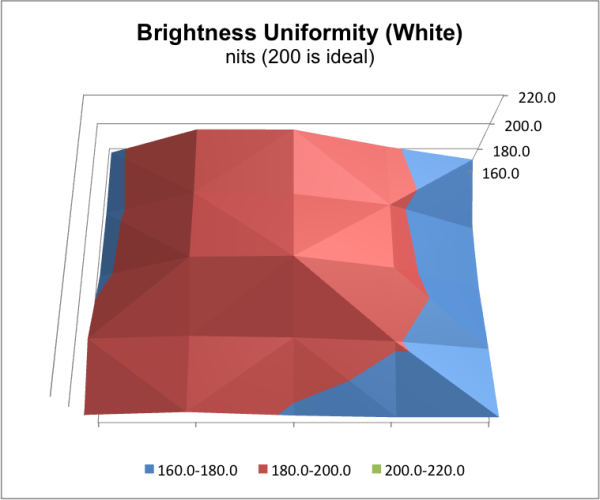
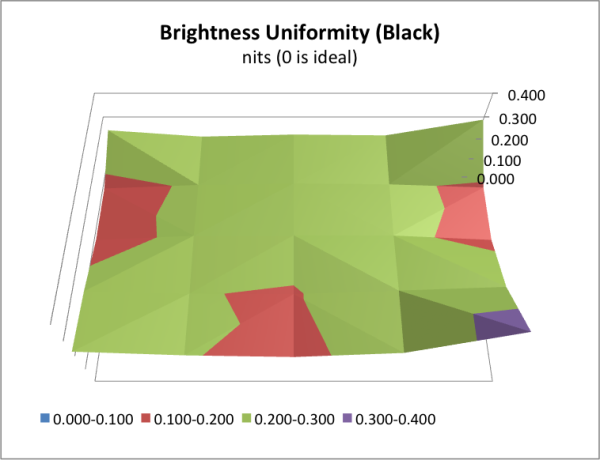
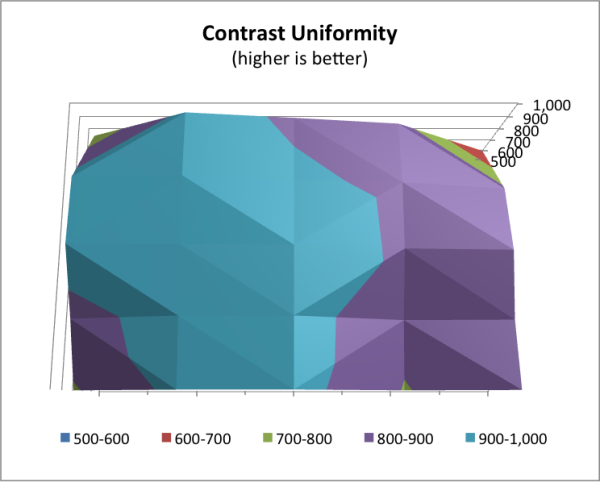
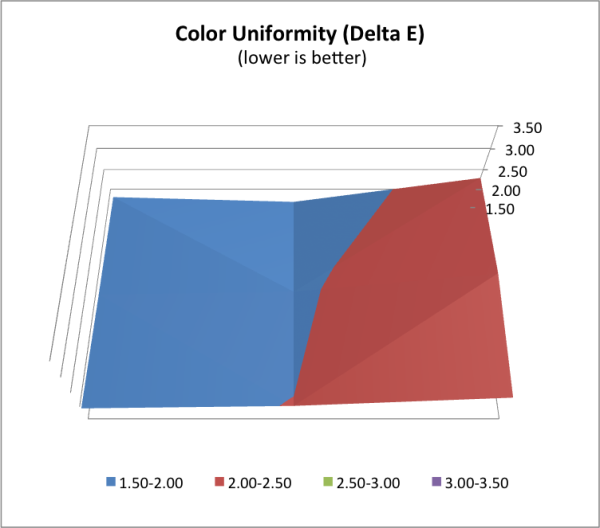
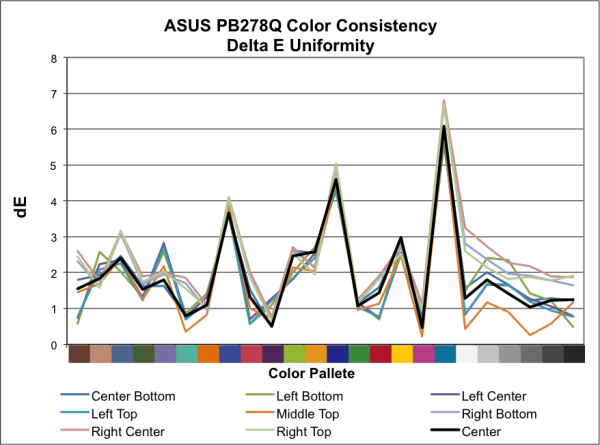








55 Comments
View All Comments
Old_Fogie_Late_Bloomer - Wednesday, November 21, 2012 - link
I don't really mind the 16:9 aspect ratio so much anymore; it's the 1080 lines of resolution that get me. I have a 1600x1200 monitor and a 1920x1080 monitor at work...the former is my primary monitor, 'cause those 120 pixels matter when coding or looking at spreadsheets. I'd swap the 1080p monitor for another UXGA one if I could (but I was lucky to office-scavenge the one I have :-P ).If manufacturers wanna go 4K at a reasonable price, that's fine. Otherwise, I guess my next monitor purchase will probably be a U2711 (or another U2410).
devilmon - Tuesday, November 20, 2012 - link
I think you forget to test about Responsiveness of pixel on this monitor. I think overdrive / response time compensation (RTC) technology is the best feature that cannot found in other high-end monitor.PS. I'm quite surprise why your test result is far from another review. Do you use defect monitor?
http://www.tftcentral.co.uk/reviews/asus_pb278q.ht...
Ryan Smith - Tuesday, November 20, 2012 - link
We don't have pixel response time tests with different TraceFree settings, but we do have tests at the stock setting of 60.http://images.anandtech.com/doci/6460/Input%20Lag....
11ms pixel response time + 17ms input lag
cheinonen - Tuesday, November 20, 2012 - link
TraceFree doesn't affect the lag time at all in my testing. I ran SMTT at all the various TraceFree settings and that doesn't change the lag at all. It does change the ghosting of the LCD which I did comment on, but it didn't change the lag in my testing.Krysto - Tuesday, November 20, 2012 - link
Nexus 10 has a PLS screen, too. And it's actually slightly higher resolution than this.dingetje - Tuesday, November 20, 2012 - link
thx for the reviewif have a question:
will the EVGA Z77 Stinger Mini-ITX Motherboard be in the upcoming mini itx round-up article?
fragemall - Tuesday, November 20, 2012 - link
I think its time to move on from using excel to generate those surface plots. Virtually any software (including Matlab) can be used to make a better figure.cheinonen - Tuesday, November 20, 2012 - link
I'm aware of this and have been working on making the charts better, I just haven't decided on something yet but will try to figure it out soon.Crazyeyeskillah - Tuesday, November 20, 2012 - link
It's too bad the lag is so high, that is incredibly noticeable and you will feel it in every fps game you play, there is no covering it up, this is not a gaming monitor but a graphics/editing monitor, don't waste your money if you are a gamer. Scaler=FailerSubyman - Tuesday, November 20, 2012 - link
I recently purchased a Viewsonic VP2770 that uses a PLS panel. I'm enjoying it more than the IPS panels I've had in the past. It has all the features that I was looking for such as non-PWM backlight, USB 3.0 hub, 27", 1440p, good selection of inputs, and a good stand. Too bad more places do not review it.